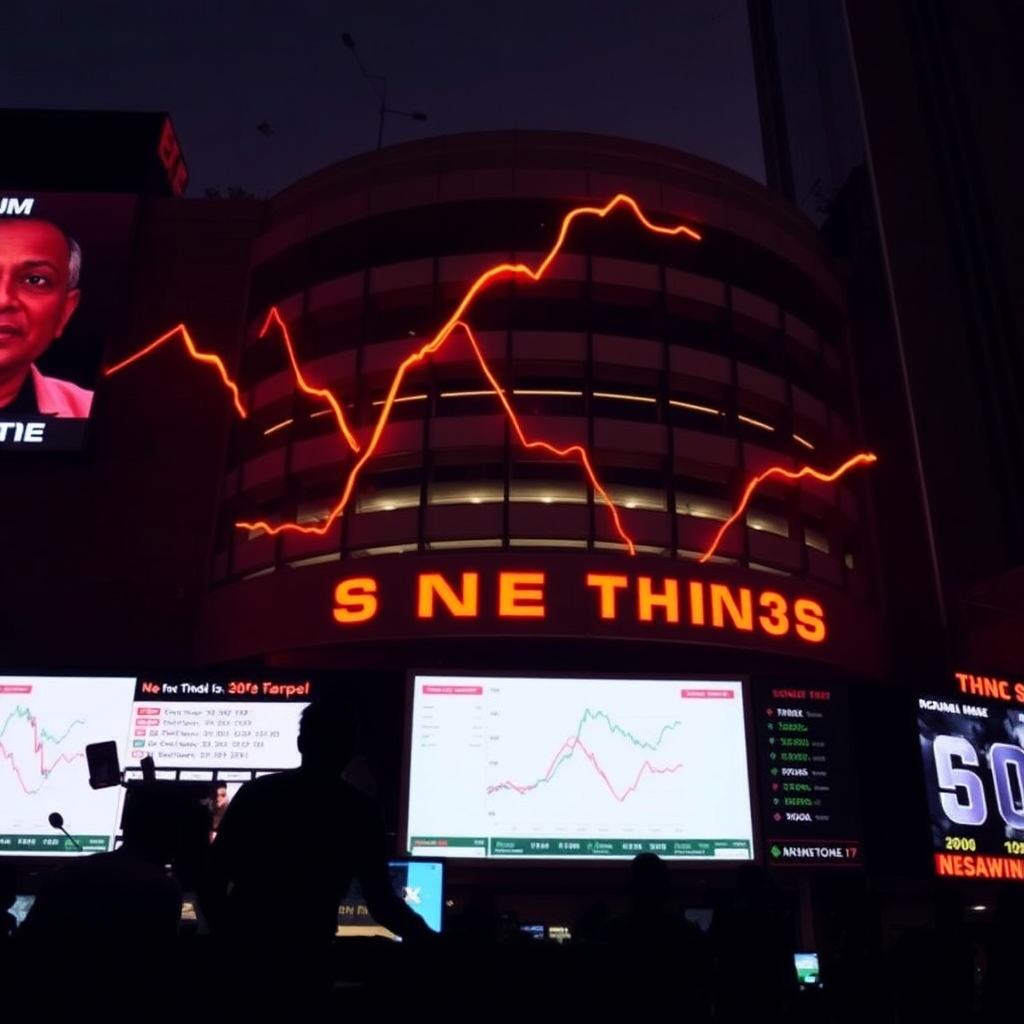
On a turbulent day for Indian stock markets, the Sensex plunged by 1,000 points, while the Nifty index dropped by 1.35%. The dramatic market slump has left investors anxious, and many are wondering what’s driving the sharp decline. For the average investor, the drop in both indices is a reminder of the volatility inherent in stock markets, especially as external factors exert pressure.
While some market corrections are expected over time, the current slump has been driven by a combination of global economic factors, disappointing corporate earnings, and both geopolitical and domestic political uncertainties. This article delves into the three key reasons behind this slump, offering a detailed analysis to help investors understand the broader forces at play.
1. Global Economic Factors: Rising Inflation and Interest Rate Concerns
One of the primary contributors to the recent downturn in the Indian stock market is the global economic environment, which continues to pose risks for emerging markets like India. Two major concerns driving the slump are persistent global inflation and the interest rate hikes being implemented by central banks worldwide, particularly the US Federal Reserve.
Rising Global Inflation
Inflation has been a growing concern for many economies worldwide. Despite efforts to control rising prices, inflation rates remain stubbornly high in many developed nations, particularly in the United States and parts of Europe. This has had a cascading effect on global markets, with central banks resorting to tighter monetary policies to bring inflation under control.
In India, inflationary pressures have been felt through higher food and fuel prices, which, in turn, impact the cost of living and the purchasing power of the average consumer. As global inflation shows no signs of abating in the short term, many investors are worried that these conditions will worsen in the coming months, thereby dampening the potential for economic growth in both developed and emerging markets.
Interest Rate Hikes and Tightening Monetary Policies
To combat rising inflation, many central banks around the world, led by the Federal Reserve in the US, have raised interest rates significantly in recent months. The higher borrowing costs that result from these interest rate hikes have made financing more expensive, potentially leading to slower economic growth.
The impact of this is far-reaching. As interest rates rise, bond yields also climb, making fixed-income securities more attractive compared to stocks. This can lead to capital outflows from emerging markets like India, as foreign investors seek safer, higher-yielding investments in developed markets. Additionally, higher borrowing costs could slow down capital expenditure (capex) growth and consumer demand, especially in interest-sensitive sectors like real estate, automobiles, and consumer durables.
2. Corporate Earnings Disappointments: Slower Growth and Margin Pressure
Another significant factor contributing to the market slump is the disappointing earnings reports from many top companies across various sectors in India. While India’s economy had shown signs of recovery post-pandemic, many companies are now facing slower-than-expected growth, rising input costs, and shrinking profit margins.
Slower Earnings Growth in Key Sectors
India’s stock market is heavily influenced by the performance of large-cap companies, especially in sectors like information technology (IT), automobiles, and banking. For instance, IT companies that have been the star performers of the last decade are now grappling with several challenges.
With the global slowdown, especially in the US and Europe, demand for IT services has weakened. Companies like Tata Consultancy Services (TCS) and Infosys have reported lower-than-expected growth in their latest quarterly results. Furthermore, the appreciation of the Indian rupee against the US dollar has eroded earnings from international markets, adding to the woes.
The automobile sector is also facing headwinds due to rising input costs, especially with the surge in the price of raw materials like steel and aluminum. This, combined with inflationary pressures, has led to a slowdown in vehicle sales, particularly in the premium segment. Companies like Maruti Suzuki and Tata Motors have reported lower margins as a result of these rising costs.
The banking sector, traditionally a key driver of stock market growth in India, has also shown signs of strain. While private banks like HDFC Bank and ICICI Bank have continued to perform relatively well, the sector overall is facing challenges in the form of rising non-performing assets (NPAs) and slower credit growth.
Rising Input Costs and Margin Compression
The most concerning aspect for investors is margin compression, which is a direct result of rising input costs. Companies are increasingly finding it difficult to pass on higher costs to consumers due to stiff competition and changing consumer preferences. This has put pressure on profit margins, and in turn, corporate earnings growth.
As profit growth slows, stock prices begin to correct, especially for high-valuation companies. This can trigger a sell-off, as investors re-evaluate their expectations of future earnings. The ripple effect is felt across the market, contributing to the overall market decline.
3. Geopolitical and Domestic Political Uncertainty: Heightened Risk
In addition to global economic pressures, geopolitical tensions and domestic political uncertainty have contributed to the current market slump. These factors have created an environment of heightened risk, which has led to investors pulling back.
Geopolitical Tensions
Globally, geopolitical tensions have been escalating, particularly with the ongoing Russia-Ukraine war. Despite diplomatic efforts, the war has continued to disrupt supply chains, especially in energy and agricultural commodities. The war’s impact on global energy prices and inflationary pressures has had a knock-on effect on global markets, and India has not been immune.
In addition to the Russia-Ukraine conflict, tensions between China and Taiwan continue to raise concerns about potential instability in the Asia-Pacific region. These geopolitical risks often lead to capital flight from emerging markets like India, as investors seek safer havens for their money.
Domestic Political Uncertainty
On the domestic front, political uncertainty is also contributing to market volatility. With state elections in key regions scheduled for next year and the general elections approaching in 2024, there is a sense of unease regarding political stability. Market participants often react nervously to election cycles, especially if there is any perceived risk of policy changes that could impact businesses and the economy.
India’s stock market has historically been sensitive to political developments, and as the country heads toward its general elections, the uncertainty surrounding the outcomes can cause fluctuations in market sentiment.
Sector-Specific Impact: A Deep Dive into the Hard-Hit Sectors
Certain sectors have been hit harder than others in this current market downturn. These include technology, automobiles, and consumer goods.
Technology Sector
The IT sector has been underperforming due to the global slowdown. Companies that were once the darling of the stock market are now facing challenges related to slower growth and foreign exchange headwinds. Additionally, as clients in developed countries reduce their technology spending, the outlook for Indian IT companies becomes uncertain.
Automobile Sector
The automobile sector has also seen a slowdown due to rising raw material costs and inflationary pressures. The sector’s growth, which had been strong post-pandemic, has been dampened by consumers cutting back on big-ticket purchases and facing higher financing costs due to interest rate hikes.
Consumer Goods
Consumer goods companies are also seeing slowdowns as rising inflation impacts discretionary spending. As prices for everyday essentials like food, fuel, and healthcare increase, consumers are spending more on necessities and less on non-essential goods.
Market Sentiment: The Psychology Behind the Sell-off
Market sentiment plays a huge role in driving stock market fluctuations. Investor psychology often leads to panic selling during times of uncertainty. This sell-off, once triggered, can lead to a downward spiral, as fear and uncertainty take over.
Retail investors, who are more prone to emotional decision-making, may panic when they see sharp declines in stock prices, leading to a further loss of value. This herd mentality can exacerbate market downturns, creating short-term volatility even when the long-term outlook remains strong.
What’s Next for the Indian Stock Market?
Looking ahead, there are several factors that could help stabilize the market. Central banks around the world, including India’s Reserve Bank of India (RBI), may adjust monetary policies to accommodate the changing global economic environment. Additionally, the government’s fiscal policies and election results could help provide some clarity to investors, which might improve market sentiment.
However, investors should remain cautious in the short term as volatility is expected to persist. Those who can weather the storm may find opportunities to buy quality stocks at a discount, positioning themselves for a potential recovery once the market stabilizes.
The recent slump in India’s stock markets is driven by a combination of global economic factors, disappointing corporate earnings, and both geopolitical and domestic political uncertainties. While these factors have caused significant market turbulence, India’s long-term growth story remains intact. Investors should stay informed, be cautious in the short term, and take advantage of any potential opportunities for growth as the market stabilizes.
Visit our other website: https://synergypublish.com


